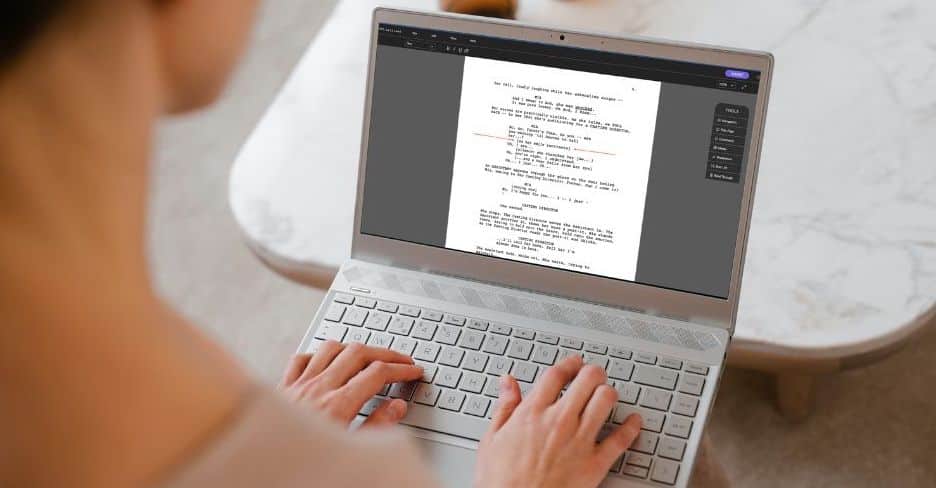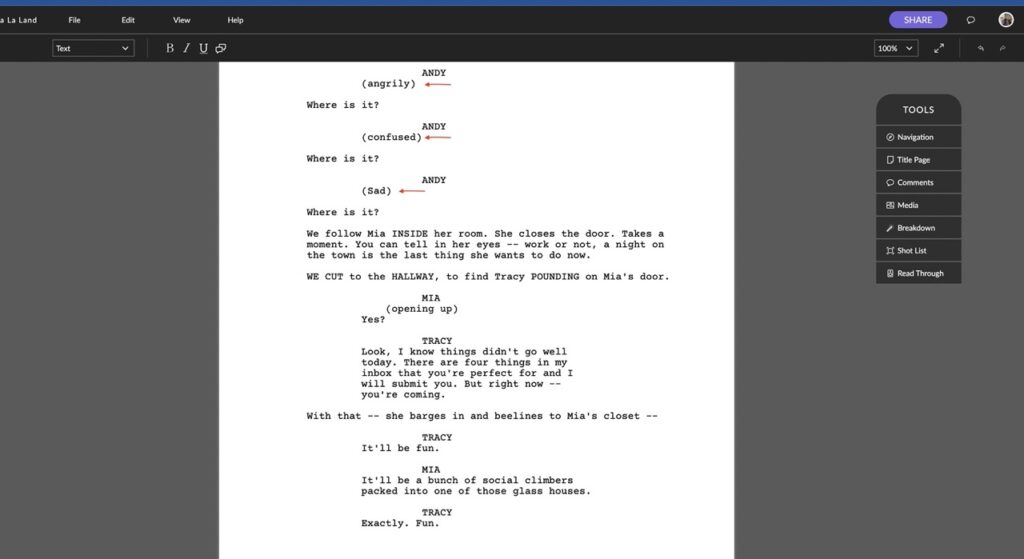
When it comes to crafting a script, there are so many tools in the writer’s toolkit to help bring characters to life. While dialogue is undoubtedly important, there’s another powerful tool at your disposal, the parenthetical.
What are Parentheticals?
Essentially it’s a line of text that appears in parentheses underneath a line of dialogue. Its primary purpose is to give the actor a little direction on how you imagine the delivery of the line if the context isn’t clear in action.
For example:
ANDY
(angrily)
Where is it?
ANDY
(confused)
Where is it?
ANDY
(Sad)
Where is it?

Including a parenthetical like this can change the entire context of a scene.
But parentheticals aren’t only beneficial for actors; they’re also a useful way to express your screenwriting style and can be used in several different ways.
Types of Parentheticals
Now we’ve covered what parentheticals are, let’s look at the different types you can use in your screenplay.
There are three main types of parentheticals you can use in your screenplay: explanatory, rhetorical, and asides.
Explanatory Parentheticals
Explanatory parentheticals, as the name suggests, provide further explanation or clarification for the dialogue. These parentheticals are used to explain the way a character speaks or to convey additional information that isn’t included in the dialogue or action.
For example:
AMANDA
(whispering)
There’s someone outside.
In this example, the parenthetical “(whispering)” provides the reader or actor with more information on how the line should be delivered.

Rhetorical Parentheticals
Rhetorical parentheticals are used to indicate the intended delivery of a line. These parentheticals provide instructions on the tone or emphasis that should be used. For example:
YOUNG WOMAN
Well, what else is there, day jobs?
YOUNG MAN
(laughing)
Not this life.
Here, the parenthetical “(laughing)” informs the actor on how the line should be delivered to convey the necessary emotion and meaning.

Asides Parentheticals
Asides, on the other hand, are parentheticals that are meant to be spoken directly to the audience, breaking the fourth wall. They are often used for comedic effect or to give the audience more insight into a character’s thoughts or feelings. For example:
WADE
(to the camera)
Can you believe she said that?

Asides can be tricky to use effectively, as they can easily take the audience out of the story. However, when used correctly, they can add a layer of depth and humor to a script.
Examples of this style can be seen in the TV series Fleabag and the movie, Deadpool.
It’s important to be able to distinguish between these different types of parentheticals, as each serves a specific purpose in conveying the writer’s intent. Be sure to use them judiciously and with intention.
How to Format Parentheticals
Here are some tips for correctly formatting your parentheticals:
▪ Avoid capital letters.
▪ Don’t use dashes, ellipses or full stops.
▪ Keep them brief.
▪ Make sure it’s relevant.
▪ Avoid overusing them.
One of the best ways to understand how to format parentheticals is to see them in action. So why not grab a couple of your favourite screenplays and see how other writers use them. You might be surprised to see how little or how often your favourite screenwriter uses them.
Other Uses for Parentheticals
You can also use parentheticals to convey a pause in dialogue or a ‘beat. These will be used with the dialogue itself, for example.
SAM
How did you know where to come?
(beat)
I guess it doesn’t matter.
You can also use parenthetical multiple times in dialogue.
SAM
(Angrily)
Didn’t you see the stop sign?
(Calming down)
I guess everyone makes mistakes.
This can be a useful way of showing when a character’s emotion changes within a scene.
Disadvantages of Using Parentheticals
While parentheticals can be a powerful tool in a screenplay, there are also some potential drawbacks to using them.

One of the main disadvantages is that they can be overused, leading to cluttered and distracting dialogue.
Giving actors too many parentheticals can come across as controlling. Remember that an actor will work with a director to bring a scene to life and they’ll have their own instinct and style to bring to the character. Sometimes letting an actor or a director work with a scene that doesn’t have parentheticals can open up a new creative approach to a scene.
Another potential issue is that they can slow down the pace of a scene if used too frequently, making it harder for the audience or reader to stay engaged with your work.
Finally, it’s important to remember that parentheticals are not a substitute for well-crafted dialogue and can’t make up for deficiencies in character development or plot. Parentheticals should be the sprinkles on a cake, nice to have, but still a great cake without them!
Conclusion
Parentheticals are a powerful tool for screenwriters, they provide actors with direction on how to deliver dialogue and can convey additional information about a scene.
By understanding the different types of parentheticals, such as explanatory, rhetorical, and asides, writers can use them effectively and elevate a screenplay. Used well they can bring the words to life and bring new meaning to a character’s dialogue.
It’s important to keep parentheticals brief, relevant, and to use them sparingly to get the most out of them.
With these tips in mind, you can use parentheticals to add depth, humor, and emotion to your next screenplay.

